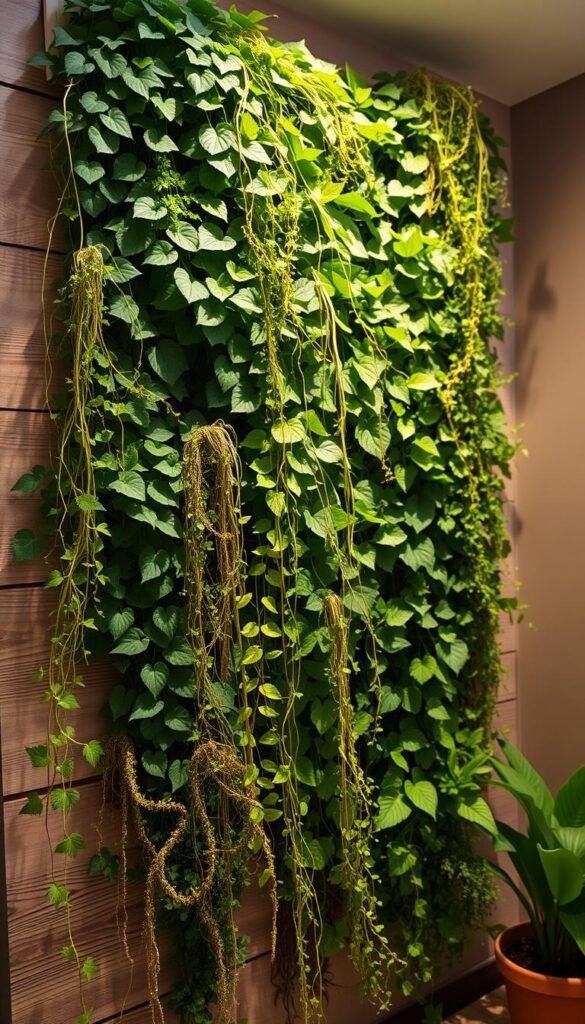Ever feel like your outdoor space could use more greenery but don’t have room to spread out? Vertical growing solutions let you turn blank walls and fences into thriving plant showcases. These creative setups aren’t just space-savers—they add texture, color, and personality to patios, balconies, and yards.
Imagine plucking fresh herbs from a living wall while your neighbor’s plain fence stares back. That’s the magic of stacking plants upward. You’ll learn how basic materials like pallets or hanging pockets can transform unused surfaces into breath-taking displays. Even tricky spots with poor soil become opportunities when you grow vertically.
This approach solves common headaches for green thumbs. Limited square footage? Vertical gardens multiply your planting area. Need privacy? Lush vines create natural screens. Crave low-maintenance beauty? Succulents thrive in wall-mounted setups with minimal watering.
We’ll walk through projects for every skill level and budget. Repurpose old gutters into herb stations or invest in modular panels for a polished look. Whether you want edible gardens or floral masterpieces, these ideas help you reimagine what’s possible above ground level.
Introduction to Vertical Garden Ideas

What if you could grow twice as many flowers or herbs without sacrificing precious ground area? Vertical gardening flips traditional planting methods by letting you build upward instead of outward. This approach works whether you’re tending a rooftop terrace or a studio apartment windowsill.
Successful setups rely on three core principles. Proper drainage prevents water damage to walls. Balanced weight distribution keeps structures secure. Choosing the right plants—like trailing ivy or compact strawberries—ensures they thrive in upright conditions.
Urban dwellers love these systems because they turn cramped balconies into lush retreats. Even basic setups, like repurposed shoe organizers or wall-mounted troughs, add life to blank surfaces. For those wanting grandeur, irrigated living walls can span entire exteriors with cascading foliage.
Beyond saving space, vertical designs create natural privacy screens. Imagine morning glories climbing a trellis to block street noise or herbs shielding your patio from nosy neighbors. These gardens adapt to your climate too—succulents thrive in sunny dry spots, while ferns prefer shaded humid corners.
The best part? You control the maintenance level. Self-watering panels handle thirsty plants, while drought-tolerant species need minimal care. Whether you’re a weekend gardener or a busy professional, there’s a vertical solution that fits your lifestyle.
Innovative DIY Planter Projects

Why let old household items gather dust when they can become thriving green spaces? These clever transformations turn forgotten objects into conversation-starting displays that save money and reduce waste. Best part? You likely already own most materials needed.
Colander Charmers & Eco-Friendly Pouches
That unused pasta strainer makes a perfect hanging planter. Drill drainage holes (most colanders have them ready), add soil, and watch herbs like thyme cascade over the edges. “Metal develops a rustic patina that complements trailing plants beautifully,” notes urban gardener Lisa Chen.
For wall-mounted options, try biodegradable pockets with reinforced grommets. These durable planters attach securely with screws while breaking down naturally over time—ideal for temporary installations or renters.
Pallet Walls & Vintage Window Frames
Wooden shipping pallets become instant vertical gardens when stood upright. Secure pots within the slats or line the structure with landscape fabric for direct soil filling. Lean two against a wall for a freestanding green divider.
Old windows gain new purpose as climbing supports. Remove glass panes safely, then hang the frame where jasmine or clematis can weave through the mullions. Within weeks, you’ll have a living stained-glass effect.
These projects prove that gardening ingenuity often starts with what others discard. By repurposing materials creatively, you craft unique growing spaces while keeping usable items from landfills.
Creative Hanging Planters for Vertical Gardens

Who says your plants need to stay grounded? Elevate your greenery with suspended displays that combine practicality with eye-catching design. These solutions work wonders in tight spaces while adding depth to your decor.
Mason Jar Magic
Turn spare glass jars into airy homes for herbs or succulents. Secure them to beams or shelves using thick jute rope, creating staggered levels. Pro tip: Use wide-mouth containers for easy planting and watering. “The transparent glass lets you monitor root health at a glance,” advises container gardening expert Mia Torres.
Wall-Mounted Freshness
Install sleek hanging wall planters near sunny windows for instant herb access while cooking. Choose self-watering models to reduce maintenance. For heavier pots, use toggle bolts in drywall or anchor directly into studs for stability.
Mix different-sized containers on adjustable hangers to create visual rhythm. Rotate plants seasonally—swap mint for pansies when temperatures drop. This flexibility lets you experiment without committing permanent changes to your space.
Remember: Always test weight limits before loading planters with soil. Distribute heavier items near support points, and use waterproof trays to protect surfaces below. With smart placement, you’ll maximize vertical real estate while keeping floors clutter-free.
Vertical Garden Ideas Using Upcycled Materials
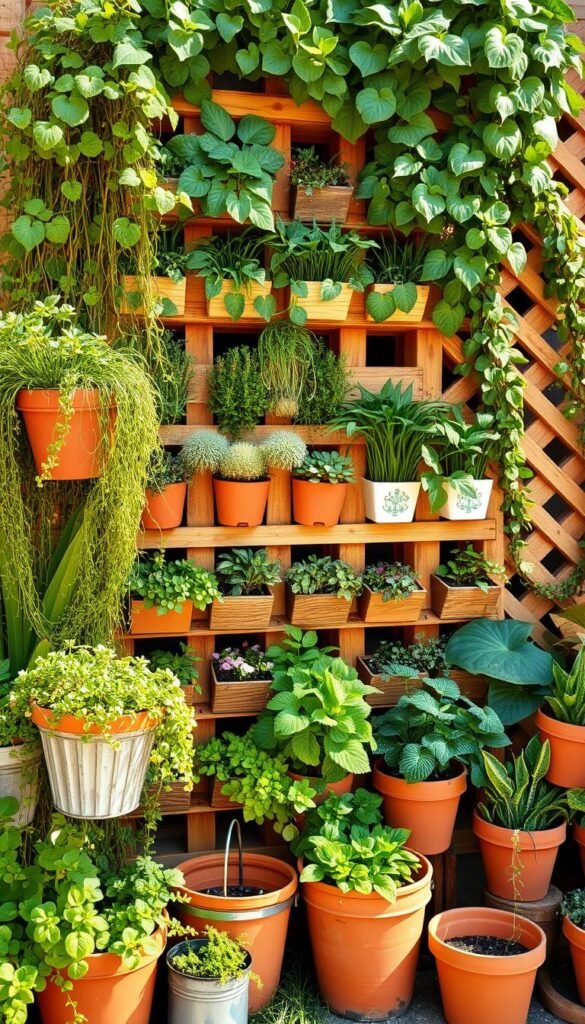
Turn trash into treasure by converting unused objects into vibrant plant homes. With simple tools and creativity, you can craft functional displays that breathe life into dull walls while keeping materials out of landfills. These projects prove sustainability and style go hand-in-hand.
Upcycled Vertical Planters
Old trash bins become instant eye-catchers when hung vertically. Drill drainage holes in the bottom, then secure them to fences using weatherproof rope or twine. “Metal containers develop a rustic charm as they age,” says DIY enthusiast Marco Ruiz. Paint bins bold colors like cobalt blue or sunflower yellow to complement your outdoor palette.
Wooden Box Wall Planter
Scrap wood pieces transform into custom planters with basic tools. Nail together a shallow box, line it with landscape fabric, and attach it securely to surfaces using L-brackets. This approach lets you match container sizes to specific plants—compact herbs in narrow boxes, trailing vines in deeper ones.
Seal raw wood with outdoor-grade stain to protect against moisture. For a modern twist, alternate painted and natural boxes on your wall. These creative ways to reuse materials often improve airflow around roots compared to solid pots. Plus, they add texture that mass-produced planters can’t match.
Modern Vertical Garden Doorway and Shelf Displays

Your front entry deserves more than just a welcome mat—imagine framing it with living greenery. Vertical designs turn transitional spaces into botanical showcases that blend form and function. These installations elevate curb appeal while maximizing underused areas around doors and windows.
Archway Transformations
Climbing vines like clematis or wisteria create natural canopies above door frames. Install metal or wooden supports to guide growth patterns. “A well-designed archway becomes part of your home’s architecture,” notes landscape designer Elena Martinez. Pair flowering plants with evergreen varieties for year-round structure.
Modern shelf systems offer sleek alternatives for contemporary spaces. Powder-coated steel units hold geometric planters filled with air plants or cascading succulents. These modular displays adapt to any wall size—perfect for urban homes with limited ground space.
| System Type | Best Plants | Maintenance Level | Aesthetic |
|---|---|---|---|
| Climbing Vine Archways | Jasmine, Ivy | Moderate | Romantic |
| Modular Shelving | Succulents, Herbs | Low | Contemporary |
| Hanging Pocket Panels | Ferns, Begonias | High | Bohemian |
Professional landscapers recommend reinforced mounting systems for heavy planters. Hidden irrigation lines keep plants hydrated without visible tubing. For evening impact, weave string lights through foliage or install subtle LED strips along shelves.
Rotate seasonal blooms in your vertical displays to maintain visual interest. Spring pansies give way to summer petunias, followed by autumn chrysanthemums. This approach keeps your entryway vibrant while protecting walls from weather damage.
Transforming Old Fences into Garden Walls
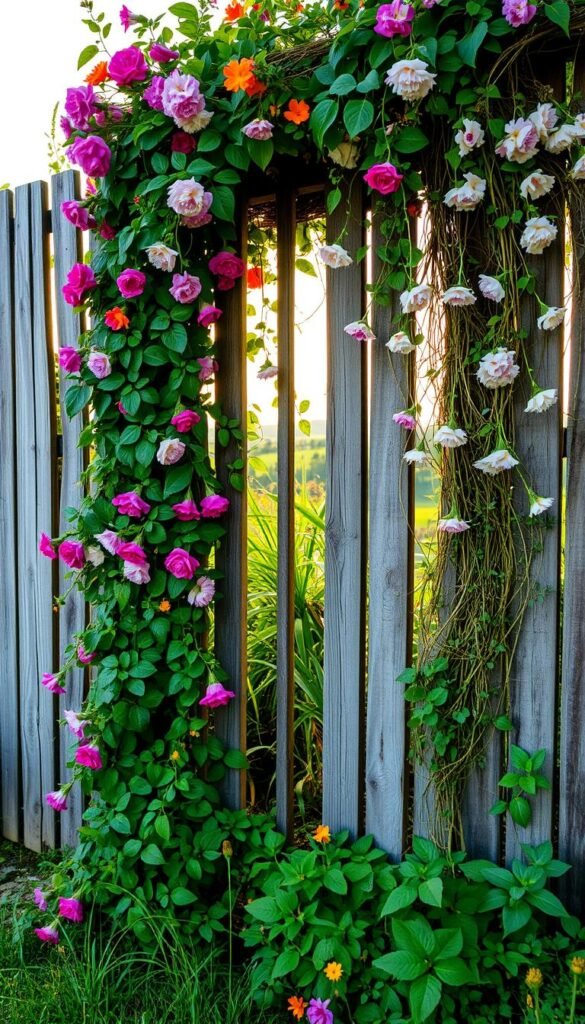
Tired of staring at that bland wooden barrier in your yard? Your fence holds untapped potential as a vertical canvas for botanical creativity. With simple materials and smart design, you can turn this overlooked structure into a living masterpiece.
Give weathered fences new life using spray-painted tin cans as planters. Choose bold hues like electric yellow or cobalt blue, then fill them with petunias or marigolds for instant curb appeal. This approach adds personality while repurposing items destined for recycling.
For modern flair, arrange identical containers in irregular patterns across the surface. Alternate between empty and planted sections to create rhythm. “The contrast between order and spontaneity makes these displays pop,” says landscape designer Clara Nguyen.
Secure containers properly based on your fence material. Use rust-proof screws for wood surfaces or heavy-duty adhesive strips for vinyl. Space planters 12-18″ apart to prevent overcrowding as greenery matures.
Pick species suited to vertical conditions. Drought-tolerant succulents work well in sunny spots, while shade-loving ferns thrive on north-facing surfaces. Include trailing varieties like ivy to soften harsh lines.
These living walls do more than look pretty. They buffer street noise, attract pollinators, and screen unwanted views. You’ll maximize every inch while keeping maintenance manageable.
Rotate blooms seasonally—pansies in spring, zinnias in summer, mums in fall. This approach maintains color year-round without overwhelming the structure. Your once-dull divider becomes a dynamic ecosystem that evolves with the months.
10 Garden Wall Ideas for Vertical Plant Displays
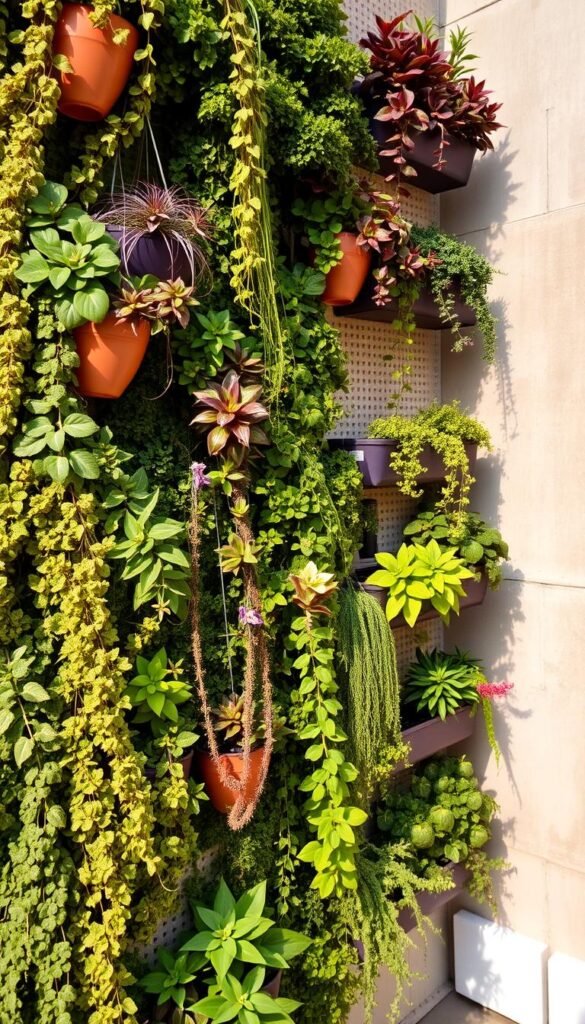
Looking to maximize your green space without sacrificing style or function? These vertical solutions turn ordinary surfaces into dynamic ecosystems. Whether you’re working with a tiny balcony or sprawling backyard, there’s a setup that fits your vision and practical needs.
Each approach tackles common challenges creatively. Pocket panel systems handle water runoff through built-in drainage layers, while modular frames let you rearrange greenery as your style evolves. For poor soil areas, wall-mounted containers let you control growing conditions precisely. Seasonal swaps become effortless—replace frost-sensitive blooms with hardy evergreens during colder months.
| Solution Type | Space Needed | Ideal Plants | Maintenance | Style |
|---|---|---|---|---|
| Pocket Panels | Compact | Herbs, Ferns | Medium | Modern |
| Modular Frames | Adjustable | Succulents | Low | Industrial |
| Repurposed Containers | Variable | Trailing Vines | High | Rustic |
| Hanging Grids | Narrow | Air Plants | Easy | Minimalist |
Urban spaces shine with geometric metal planters, while reclaimed wood installations complement cottage-style settings. Renters love temporary adhesive strips that hold lightweight planters without damaging surfaces. For permanent setups, professionals recommend powder-coated steel brackets that withstand weather extremes.
Start small with a single hanging planter near your seating area. Gradually expand using interlocking components as confidence grows. “The best displays evolve with your skills,” says Denver-based landscaper Rosa Gutierrez. Focus on plants matching your local climate—drought-tolerant species for sunny walls, moisture-loving varieties for shaded areas.
Lattice and Trellis Designs for Vertical Plant Displays
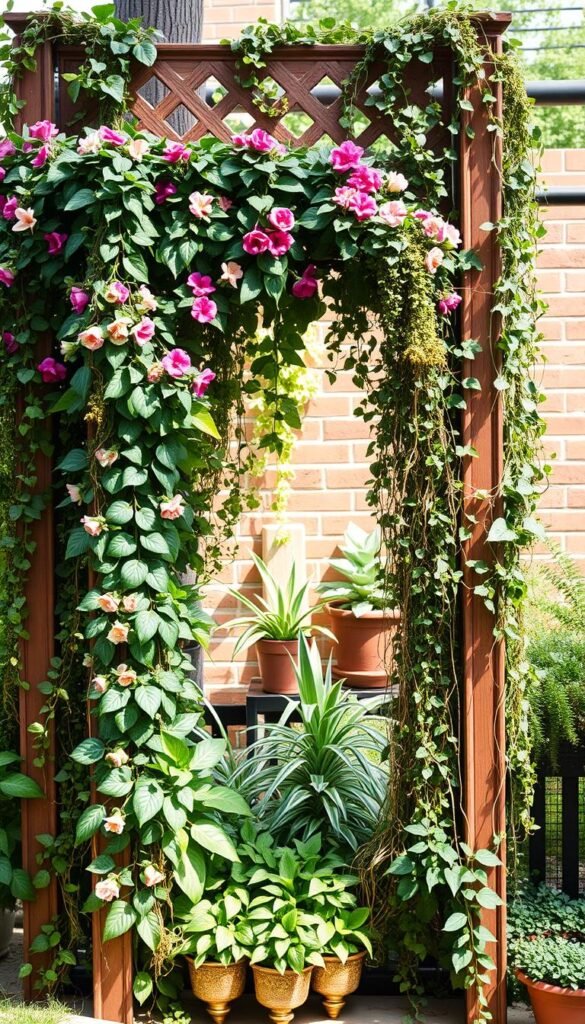
Want to add structure and style to your green walls? Trellises and lattice panels bring architectural interest while guiding plants into artistic arrangements. These supports work equally well in cozy courtyards or sprawling yards, offering solutions for both aesthetics and practical needs.
Salvaged Window Trellis & Bamboo Solutions
Old window frames become instant garden charm when repurposed as climbing aids. Remove glass panes safely, then secure the frame to a wall or fence. Train jasmine or clematis through the openings for a living stained-glass effect. “This approach preserves historical character while creating functional growing space,” notes restoration expert Liam Carter.
For natural textures, lash bamboo poles into triangular tuteurs using weatherproof twine. Morning glories or sweet peas quickly cover these rustic structures, making perfect focal points. Place them near seating areas where their vertical growth draws the eye upward.
Privacy Through Smart Design
Turn basic lattice panels into neighbor-friendly screens with strategic planting. Secure treated wood frames around lattice sheets, then position them between patios. Grapevines or climbing roses soften the geometric patterns while blocking sightlines. Trellis designs with diamond-shaped openings allow airflow while supporting dense foliage.
Control wild growers like ivy using wire guides and removable hooks. Shape vines into spirals or chevrons for living artwork that evolves through seasons. This method prevents damage to structures while letting creativity flourish.
| Trellis Type | Best Climbers | Maintenance |
|---|---|---|
| Bamboo | Annual flowers | Low |
| Lattice | Woody vines | Medium |
| Window Frame | Lightweight species | High |
Seasonal care keeps displays thriving. Prune aggressive growers monthly during peak season, and check fastener integrity before winter storms. For small-space gardening, use folding lattice panels that store flat during off-seasons. Your vertical garden remains manageable while making maximum visual impact.
Stacked and Tiered Gardening Solutions
Need height in your growing space without complicated setups? Layered arrangements maximize vertical real estate using everyday items. These clever hacks add depth to small areas while keeping maintenance simple.
Ladder Shelving Concepts
Turn an unused ladder into instant plant tiers. Lean it against a sturdy surface and place pots on each rung. Landscape timbers can stabilize the base for permanent installations. Mix trailing vines with compact herbs for visual contrast.
Stacked Crates for Layered Looks
Wooden crates become modular towers when stacked creatively. Secure them with brackets or arrange freely for flexible layouts. This approach lets you rotate plants seasonally—swap summer blooms for winter greens in minutes.
Distribute weight evenly by placing heavier containers at the bottom. Line crates with breathable fabric to prevent soil spillage. You’ll maintain neat displays while ensuring easy access for watering and pruning.
Both methods adapt as your collection grows. Start with three tiers, then expand upward or sideways. These solutions prove that smart stacking can transform even the tiniest corners into lush retreats.
